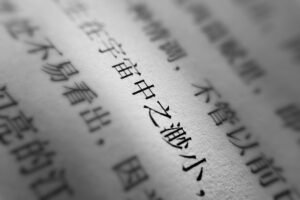Table of Contents
ToggleIntroduction
In the fascinating world of Mandarin Chinese, the nuances of temporal markers are crucial for both language learners and linguists. Two such markers, ‘先 (xiān)’ and ‘后 (hòu),’ play a pivotal role in conveying time sequences and relationships. This article delves into the subtle yet significant differences between these terms, offering insights into their usage and implications in Mandarin.
Understanding ‘先 (xiān)’
‘先 (xiān),’ often translated as ‘first’ or ‘earlier,’ is a temporal marker used to indicate precedence in time. It is commonly employed to specify that an action or event occurs before another in a sequence.
我先去商店,然后回家。(Wǒ xiān qù shāngdiàn, ránhòu huí jiā.) – “I will go to the store first, and then come home.”
请你先写作业,再看电视。(Qǐng nǐ xiān xiě zuòyè, zài kàn diànshì.) – “Please do your homework first, before watching TV.”
In these examples, ‘先’ marks the action that should happen before another. It is a directive for sequencing, emphasizing the order of occurrences.
Exploring ‘后 (hòu)’
On the flip side, ‘后 (hòu),’ meaning ‘after’ or ‘later,’ indicates that an action or event takes place following another in time. This marker is crucial for expressing sequences that focus on what happens subsequently.
吃饭后,我们去散步。(Chīfàn hòu, wǒmen qù sànbù.) “After eating, we will go for a walk.”
会议结束后,请留下来讨论。(Huìyì jiéshù hòu, qǐng liú xiàlái tǎolùn.) – “After the meeting ends, please stay to discuss.”
Here, ‘后’ indicates the subsequent action or event, emphasizing the sequence’s latter part. It guides the listener or reader to understand the chronological progression of events.
Comparative Analysis
While both ‘先’ and ‘后’ are temporal markers, their usage hinges on the aspect of the sequence they emphasize. ‘先’ is about what needs to happen first, often carrying a sense of priority or prerequisite. In contrast, ‘后’ focuses on the aftermath of the subsequent steps following an initial event.
The choice between ‘先’ and ‘后’ can also be influenced by the context and the speaker’s intention to emphasize a particular part of the sequence. For instance, when the emphasis is on completing a task before relaxation, ‘先’ would be more appropriate. Conversely, if the focus is on what to do after a particular event, ‘后’ becomes the marker of choice.
Practical Implications for Language Learners
For learners of Mandarin, understanding the nuances of ‘先’ and ‘后’ is crucial for several reasons:
Accurate Communication: Using the correct temporal marker ensures the intended sequence of events is communicated, avoiding potential misunderstandings.
Cultural Insights: These markers reflect the importance placed on order and sequence in Chinese culture, highlighting cultural nuances in communication.
Advanced Proficiency: Mastery of such temporal nuances indicates advanced language proficiency, enabling learners to express complex ideas and sequences more effectively.
Conclusion
In conclusion, ‘先 (xiān)’ and ‘后 (hòu)’ are more than just simple temporal markers in Mandarin; they hold the secrets to deciphering a more profound comprehension of priority and sequence in communication. As learners navigate the intricacies of these terms, they gain linguistic competence and cultural insight, enhancing their overall proficiency in Mandarin Chinese.
FAQ: ‘先 (xiān)’ vs. ‘后 (hòu)’ in Mandarin
Q1: What is the fundamental difference between ‘先 (xiān)’ and ‘后 (hòu)’ in Mandarin?
A1: ‘先 (xiān)’ translates to ‘first’ or ‘earlier,’ indicating that an action or event occurs before another. ‘后 (hòu),’ meaning ‘after’ or ‘later,’ suggests that an action or event happens following another.
Q2: Can you give a simple example to illustrate the use of ‘先 (xiān)’?
A2: Sure! For example, “我先吃饭,然后工作” (Wǒ xiān chīfàn, ránhòu gōngzuò), which means “I will eat first, and then work.”
Q3: How is ‘后 (hòu)’ typically used in a sentence?
A3: ‘后 (hòu)’ is used to denote the subsequent action or event, as in “课程结束后,我会回家” (Kèchéng jiéshù hòu, wǒ huì huí jiā), meaning “After the class ends, I will go home.”
Q4: Can ‘先’ and ‘后’ be used in the same sentence?
A4: Yes, they can. For instance, “我先做运动,然后吃晚饭” (Wǒ xiān zuò yùndòng, ránhòu chī wǎnfàn) means “I will exercise first, and then eat dinner.”
Q5: Is there a cultural significance to using these temporal markers in Mandarin?
A5: Yes, the use of ‘先’ and ‘后’ reflects the cultural importance of order and sequence in Chinese communication, indicating a structured approach to activities and events.
Q6: Why is it essential for Mandarin learners to understand ‘先’ and ‘后’?
A6: Mastery of these temporal markers is crucial for accurate communication, avoiding misunderstandings, and demonstrating advanced language proficiency. It also offers insight into cultural nuances.
Q7: Are there any exceptions or exceptional cases using ‘先’ and ‘后’?
A7: Context and speaker intention can influence their use. While ‘先’ and ‘后’ generally follow the rules described, idiomatic expressions or specific contexts might require a nuanced understanding of these terms.
Q8: How can learning ‘先’ and ‘后’ help achieve fluency in Mandarin?
A8: Understanding and correctly using these markers enables learners to express complex ideas and sequences more effectively, which is a sign of advanced proficiency and contributes significantly to overall fluency.
Contact our head teacher, Chen Huimin, at info@lcchineseschool.com if you want to learn Chinese or have additional questions about our Chinese programs.
Sign up for a free trial class here.
Learn about our Internship Program in China.
Get free Chinese learning resources.
Learn about China’s 2024 Offical Holiday Schedule








